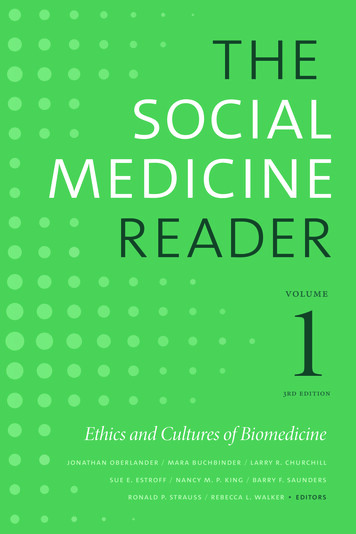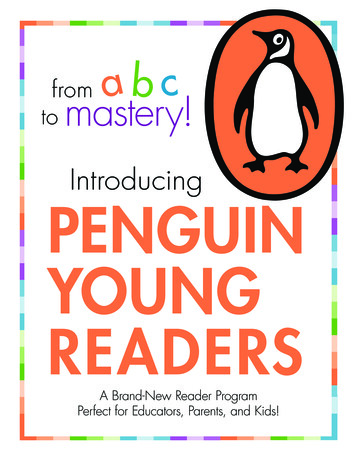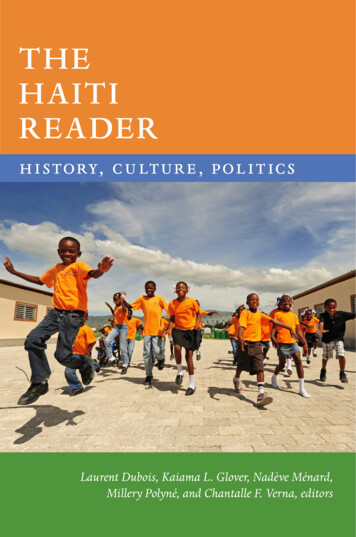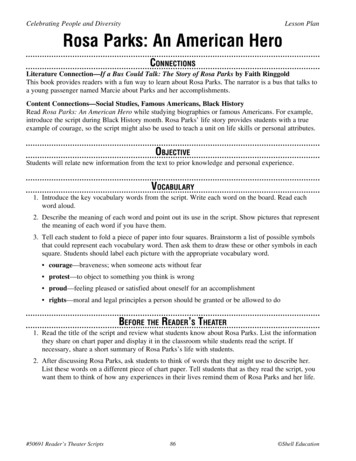
Transcription
TheSocialMedicinereader1Volume3 rd EditionEthics and Cultures of BiomedicineJonathan Oberlander / Mara Buchbinder / Larry R. ChurchillSue E. Estroff / Nancy M. P. King / Barry F. SaundersRonald P. Strauss / Rebecca L. Walker Editors
The Social Medicine ReaderVolume 1, Third Edition
The Social Medicine Readervolume1third editionEthics and Cultures of BiomedicineJonathan Oberlander, Mara Buchbinder, Larry R. Churchill,Sue E. Estroff, Nancy M. P. King, Barry F. Saunders,Ronald P. Strauss, and Rebecca L. Walker, eds.Duke University Press · D urham and London · 2 019
2019 Duke University PressAll rights reservedPrinted in the United States of Amer i caon acid- free paper Designed by Matthew TauchTypeset in Minion Pro by WestchesterPublishing Ser vicesLibrary of Congress Cataloging- in- Publication DataNames: Oberlander, Jonathan, editor.Title: The social medicine reader / JonathanOberlander, Mara Buchbinder, Larry R. Churchill,Sue E. Estroff, Nancy M. P. King, Barry F. Saunders,Ronald P. Strauss, Rebecca L. Walker, editors.Description: Third edition. Durham : DukeUniversity Press, 2019– Includes bibliographicalreferences and index.Identifiers: lccn 2018044276 (print)lccn 2019000395 (ebook)isbn 9781478004356 (ebook)isbn 9781478001737isbn 9781478001737 (v. 1 ; hardcover ; alk. paper)isbn 9781478002819 (v. 1 ; pbk. ; alk. paper)Subjects: lcsh: Social medicine.Classification: lcc ra418 (ebook) lcc ra418 .s64242019 (print) ddc 362.1—dc23lc record available at https://lccn.loc.gov/2018044276
Contentsixpreface to the third edition1Introductionpart i. Experiences of Illness and Clinician- Patient Relationships7Silver WaterAmy Bloom15“Is She Experiencing Any Pain?”: Disability and thePhysician- Patient RelationshipS. K. Toombs20The Cost of AppearancesArthur Frank25The Ship PoundingDonald Hall27God at the BedsideJerome Groopman32The Use of ForceWilliam Carlos Williams36Sunday Dialogue: Conversations between Doctor and PatientRebecca Dresser42What the Doctor SaidRaymond Carver
part ii. Professionalism and the Culture of MedicineContentsvi45The Learning CurveAtul Gawande63The Perfect CodeTerrence Holt78Coeur d’AleneRichard B. Weinberg82The “Worthy” Patient: Rethinking the “Hidden Curriculum”in Medical EducationRobin T. Higashi, Allison Tillack, Michael A. Steinman,C. Bree Johnston, and G. Michael Harper95How Doctors Think: Clinical Judgment and the Practiceof MedicineKathryn Montgomery101Healing Skills for Medical PracticeLarry R. Churchill and David Schenck111The Hair Stylist, the Corn Merchant, and the Doctor:Ambiguously AltruisticLois Shepherd127Necessary AccessoriesNusheen Ameenuddin132The Critical Vocation of the EssayBarry F. Saunders140The Art of Medicine: Asthma and the Value of ContradictionsIan Whitmarsh145ScriptMara Buchbinder and Dragana Lassiter149Ordinary Medicine: The Power and Confusion of EvidenceSharon R. Kaufman154“Ethics and Clinical Research”: The 50th Anniversaryof Beecher’s BombshellDavid S. Jones, Christine Grady, and Susan E. Lederer
part iii. Health Care Ethics and the Clinician’s RoleviiGlossary of Basic Ethical Concepts in Health Care and ResearchNancy M. P. King175Ethics in Medicine: An Introduction to Moral Toolsand TraditionsLarry R. Churchill, Nancy M. P. King, David Schenck,and Rebecca L. Walker191Historical and Con temporary Codes of Ethics: The HippocraticOath, the Prayer of Maimonides, the Declaration of Geneva,and the ama Princi ples of Medical Ethics197Enduring and Emerging Challenges of Informed ConsentChristine Grady212Teaching the Tyranny of the Form: Informed Consentin Person and on PaperKatie Watson218A Terrifying TruthRebecca Dresser222The LieLawrence D. Grouse224Discharge Decisions and the Dignity of RiskDebjani Mukherjee229No One Needs to KnowNeil S. Calmanpart iv. Death, Dying, and Lives at the Margins239Forty Years of Work on End- of- Life Care: From Patients’ Rightsto Systemic ReformSusan M. Wolf, Nancy Berlinger, and Bruce Jennings249Try to Remember Some DetailsYehuda Amichai251Failing to Thrive?Kim SueContents167
259The Dead Donor Rule and Organ TransplantationRobert D. Truog and Franklin G. Miller263The Darkening Veil of “Do Every thing”Chris Feudtner and Wynne Morrison267Death and Dignity: A Case of Individualized Decision MakingTimothy E. Quill273Active and Passive EuthanasiaJames A. Rachels280Clinician- Patient Interactions about Requests forPhysician- Assisted Suicide: A Patient and Family ViewAnthony L. Back, Helene Starks, Cla ris sa Hsu, Judith R. Gordon,Ashok Bharucha, and Robert A. Pearlman301My Father’s DeathSusan M. WolfContentsviiipart v. Allocation and Justice311Glossary: Justice and the Allocation of Health ResourcesRebecca L. Walker and Larry R. Churchill316Dead Man WalkingMichael Stillman and Monalisa Tailor320Full Disclosure: Out- of- Pocket Costs as Side EffectsPeter A. Ubel, Amy P. Abernethy, and S. Yousuf Zafar325Seven Sins of Humanitarian MedicineDavid R. Welling, James M. Ryan, David G. Burris,and Norman M. Rich335Who Should Receive Life Support during a Public HealthEmergency? Using Ethical Princi ples to Improve AllocationDecisionsDouglas B. White, Mitchell H. Katz, John M. Luce, and Bernard Lo353about the editors355index
Preface to the Third EditionThe eight editors of this third edition of the Social Medicine Reader includesix current and two former members of the Department of Social Medicinein the University of North Carolina (unc) at Chapel Hill School of Medicine. Founded in 1977, the Department of Social Medicine, which includesscholars in medicine, the social sciences, the humanities, and public health,is committed to the promotion and provision of multidisciplinary education,leadership, ser vice, research, and scholarship at the intersection of medicineand society. This includes a focus on the social conditions and characteristicsof patients and populations; the social dimensions of illness; the ethical andsocial contexts of medical care, institutions, and professions; and resourceallocation and health care policy.This two- volume reader reflects the syllabus of a year- long, requiredinterdisciplinary course that has been taught to first- year medical studentsat unc since 1978. The goal of the course since its inception has been to demonstrate that medicine and medical practice have a profound influence on— and are influenced by— social, cultural, po liti cal, and economic matters.Teaching this perspective requires integrating medical and nonmedicalmaterials and viewpoints. Therefore, this reader incorporates pieces frommany fields within medicine, the social sciences, and humanities, representing the most engaging, provocative, and informative materials and issues wehave traversed with our students.Medicine’s impact on society is multidimensional. Medicine shapes howwe think about the most fundamental, enduring human experiences— conception, birth, maturation, sickness, suffering, healing, aging, and death—as well as the meta phors we use to express our deepest concerns. Medicalpractices and social responses to them have helped to redefine the meaningsof age, race, and gender.Social forces likewise have a power ful influence on medicine. Medicalknowledge and practice, like all knowledge and practice, are shaped by po liti cal, cultural, and economic forces. This includes modern science’s pursuitof knowledge through ostensibly neutral, objective observation and experimentation. Physicians’ ideas about disease—in fact their very definitions of
Preface to the Third Editionxdisease— depend on the roles that science and scientists play in par tic u larcultures, as well as on the vari ous cultures of laboratory and clinical science.Despite the power of the biomedical model of disease and the increasingspecificity of molecular and ge ne tic knowledge, social f actors have alwaysinfluenced the occurrence and course of most diseases. And once diseasehas occurred, the power of medicine to alter its course is constrained by thelarger social, economic, and po liti cal contexts.While the origin of these volumes lies in teaching medical students,we believe the se lections they include will resonate with a broader readership from allied health fields, the medical humanities, bioethics, arts andsciences, and the interested public. The many voices represented in thesereadings include individual narratives of illness experience, commentariesby physicians, debate about complex medical cases and practices, and conceptually and empirically based scholarly writings. These are readings withthe literary and scholarly power to convey the complicated relationshipsbetween medicine, health, and society. They do not resolve the most vexingcon temporary issues, but they do illuminate their nuances and complexities,inviting discussion and debate.Repeatedly, the readings throughout these two volumes make clear thatmuch of what we encounter in science, in society, and in everyday andextraordinary lives is indeterminate, ambiguous, complex, and contradictory. And because of this inherent ambiguity, the interwoven se lectionshighlight conflicts about power and authority, autonomy and choice, andsecurity and risk. By critically analyzing t hese and many other related issues,we can open up possibilities, change what may seem inevitable, and practiceprofessional training and caregiving with an increased capacity for reflection and self- examination. The goal is to ignite and fuel the inner voices ofsocial and moral analy sis among health care professionals, and among us all.Any scholarly anthology is open to challenges about what has beenincluded and what has been left out. This collection is no exception. Thestudy of medicine and society is dynamic, with large and ever- expandingbodies of lit er a ture from which to draw. We have omitted some readingswidely considered to be “classics” and have included some readings that areexciting and new— that we believe have an indelible impact. We have chosento include material with literary and scholarly merit and that has workedwell in the classroom, provoking discussion and engaging readers’ imaginations. These readings invite critical examination, a labor of reading anddiscussion that is inherently difficult but educationally rewarding.
xiPreface to the Third EditionVolume 1, Ethics and Cultures of Biomedicine, examines experiences of illness; the roles and training of health care professionals and their relationships with patients; institutional cultures of bioscience and medicine; healthcare ethics; death and dying; and resource allocation and justice. Volume 2,Differences and Inequalities, explores health and illness, focusing on howdifference and disability are defined and experienced in con temporaryAmer i ca, and how social categories commonly used to predict diseaseoutcomes— gender, race/ethnicity, and social class— shape health outcomesand medical care.We thank our teaching colleagues who helped create and refine all threeeditions of this reader. Th ese colleagues have come over the years from bothwithin and outside the Department of Social Medicine and the University ofNorth Carolina at Chapel Hill. Equal gratitude goes to our students, whosecriticism and enthusiasm over four de cades have improved our teaching andhave influenced us greatly in making the se lections for the reader. We thankthe Department’s faculty and staff, past and pres ent; students and colleaguesfrom Vanderbilt University School of Medicine and Wake Forest Schoolof Medicine have similarly been instrumental. We especially thank KathyCrosier, the course coordinator for our first- year class, who assisted withthe preparation of the Reader. The editors gratefully acknowledge supportfrom the Department of Social Medicine, University of North Carolina atChapel Hill School of Medicine; the Center for Biomedical Ethics and Society, Vanderbilt University School of Medicine; and the Center for Bioethics,Health, and Society, Wake Forest University.
IntroductionThis first of the two volumes that comprise the Social Medicine Reader thematically explores the experiences of illness; the roles and training of healthcare professionals and their relationships with patients alongside the broadercultures of biomedicine; ethics in health care; experiences and decisions ying, and struggling to live; and par tic u lar manifestations ofregarding death, dinjustice in the broader health system. The volume’s readings, which includenarratives, essays, cases studies, fiction, and poetry, have been “road- tested”in social science, ethics, and humanities classes in health professional schoolsand gradu ate and undergraduate programs. They have been used to stimulatedebate and small-group interactions or exercises, and they have served aslaunching points for larger class discussions. We do not cover any contentarea completely; our goal instead is to provide stimulating selected readingsfrom which to engage students in discussion and deeper investigation.The eight editors of this volume are diverse in their scholarly backgrounds,expertise, and teaching styles. We each teach the same materials differentlyand have learned much from each other through many years of facultymeetings focused on teaching and pedagogy. Our collaboration exemplifiesthe adaptability of the volume’s readings to a variety of formats, settings, andapproaches.Beginning this volume with experiences of illness helps to ground thenature and meaning of sickness and healing in the familiar yet uniquely experienced state of being a patient. All health care providers have been, and willbe again, patients and family members of patients. Vivid narratives aboutmanaging illness in daily life help build understanding of the vantage pointsof patients and family members who participate in illness experiences. Teachers and students unaccustomed to fiction and poetry in the classroom may besurprised at how readily t hese materials can stimulate rich and nuanced discussion of profoundly significant issues— especially when read aloud. Whilethe first part of the volume is particularly rich in t hese forms of lit er a ture,such se lections appear in most other parts of the volume as well.In the second part of the volume, medical socialization and the doctor- patient relationship are considered. Social scientists have extensively examined
Introduction2the pro cesses that transform medical students into counselors of healthand interveners in issues of life and death. Professions, like other socialgroups, have cultures: they have specialized languages and ways of understanding, norms of be hav ior, unique customs, rites of passage, and codes ofconduct. Students are socialized into the “culture of biomedicine” in a trainingpro cess that changes the student through direct contact with and knowledgeof the most personal aspects of h uman existence. Many students enter medicalschool with idealistic views of medicine, its goals, and its basis in evidence. Asthey learn the ideology and ethics of medicine and uncover the complex evidence base that medicine puts into practice, they may face uncertainty that istoo often left unstated in public; they may undergo profound changes in theirperspectives and even their identities. Th ese readings promote reflection onthe roles of health professional students and prac ti tion ers, on the challengesinherent in the physician- patient relationship, and on navigating betweenprofessional and personal experiences, values, and truths.The third part of the volume turns to a more explicit focus on health careethics. This section includes narratives (fiction and nonfiction) of clinicianand patient experiences, as well as theoretical framing and professional guidance. Readings examine moral reasoning and what it means to have a morallife as a clinician in relationships with patients. Fundamental moral preceptsin health care practice— truth- telling, informed consent, privacy, autonomy,and beneficence— are addressed in their own right and also presented in casesand stories that pose prob lems to be unraveled, examined, and debated froma wide range of viewpoints. In this section, complex ethical issues are presented as dynamic: embedded in time, place, society, history, and culture, andentangled in multiple relationships.The fourth part of this volume employs the prior themes to address decision making, policies, and experiences at the margins of life— includingdeath, dying, and struggling to live. The work of this section includes an effortto clarify concepts; an examination of significant social disagreements andmoments in end- of- life decision making; and specific attention to life prolongation, treatment withdrawal, and the ending of life, w hether welcomeor unwelcome. Questions are raised about the legal, ethical, and practicalmedical aspects of end- of- life care, the nature and power of medical judgments, and long- standing professional and personal disagreements aboutthe end of life. Poetry, personal narrative, and the voices of patients and theirfamilies open the possibility for discussion of morality, meaning, loss, grief,and profound uncertainty in the face of death.
3IntroductionThe final section of this volume approaches justice and allocation througha few examples not commonly addressed in texts on distributive justice ecause there are many more comprehensive treatments ofin health care. Bhealth- related justice issues in other volumes, our goal here is to introducethe relevant concepts and illustrate the wide diversity of ways in which injustice is hiding in plain sight in medicine.The variety of readings in this volume can be addressed productively fromdif fer ent disciplinary perspectives and in many teaching styles and formats. These readings are readily combined with those from volume 2 of the SocialMedicine Reader, titled Differences and Inequalities. Readings from bothvolumes can be reshuffled and recombined, stand together or alone, or besupplemented by other lit er a ture. A key to using t hese readings successfullyis to approach them with flexibility—as helping to shape the right questionsrather than giving par tic u lar answers. Our hope is that both teachers andstudents of materials like these will go on asking questions, and finding dif fer ent and deeper answers, all their lives.
cine. Founded in 1977, the Department of Social Medicine, which includes scholars in medicine, the social sciences, the humanities, and public health, is committed to the promotion and provision of multidisciplinary education, leadership, service, research, and scholarship at t










